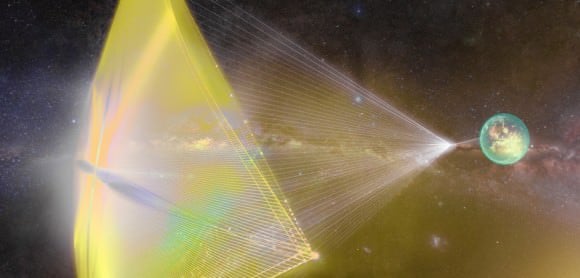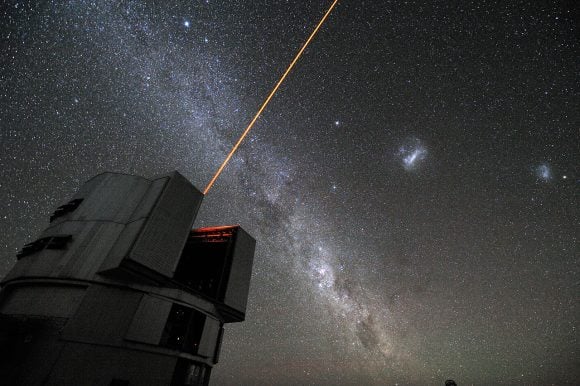Finding examples of intelligent life other than our own in the Universe is hard work. Between spending decades listening to space for signs of radio traffic - which is what the good people at the
SETI Institute
have been doing - and waiting for the day when it is possible to send spacecraft to neighboring star systems, there simply haven't been a lot of options for finding extra-terrestrials.
But in recent years, efforts have begun to simplify the search for intelligent life. Thanks to the efforts of groups like the
Breakthrough Foundation
, it may be possible in the coming years to send
"nanoscraft" on interstellar voyages
using laser-driven propulsion. But just as significant is the fact that developments like these may also make it easier for us to detect extra-terrestrials that are trying to find us.
Not long ago, Breakthrough Initiatives made headlines when they announced that luminaries like
Stephen Hawking and Mark Zuckerberg
were backing their plan to send a tiny spacecraft to Alpha Centauri. Known as
Breakthrough Starshot
, this plan involved a refrigerator-sized magnet being towed by a laser sail, which would be pushed by a ground-based laser array to speeds fast enough to reach Alpha Centauri in about 20 years.
In addition to offering a possible interstellar space mission that could reach another star in our lifetime, projects like this have the added benefit of letting us broadcast our presence to the rest of the Universe. Such is the argument put forward by Philip Lubin, a professor at the University of California, Santa Barbara, and the brains behind Starshot.
In a paper titled "
The Search for Directed Intelligence
" - which appeared recently in
arXiv
and will be published soon in
*REACH – Reviews in Human Space Exploration*
- Lubin explains how systems that are becoming technologically feasible on Earth could allow us to search for similar technology being used elsewhere. In this case, by alien civilizations. As Lubin shared with Universe Today via email:
DE-STAR, or the
Directed Energy System for Targeting of Asteroids and exploRation
, is another project being developed by scientists at UCSB. This proposed system will use lasers to target and deflect asteroids, comets, and other Near-Earth Objects (NEOs). Along with the
Directed Energy Propulsion for Interstellar Exploration
(DEEP-IN), a NASA-backed UCSB project that is based on Lubin's directed-energy concept, they represent some of the most ambitious directed-energy concepts currently being pursued.
[caption id="attachment_128417" align="aligncenter" width="580"]
Project Starshot, an initiative sponsored by the Breakthrough Foundation, is intended to be humanity's first interstellar voyage. Credit: breakthroughinitiatives.org
[/caption]
Using these as a template, Lubin believes that other species in the Universe could be using this same kind of directed energy (DE) systems for the same purposes - i.e. propulsion, planetary defense, scanning, power beaming, and communications. And by using a rather modest search strategy, he and colleagues propose observing nearby star and planetary systems to see if there are any signs of civilizations that possess this technology.
This could take the form of "spill-over", where surveys are able to detect errant flashes of energy. Or they could be from an actual beacon, assuming the extra-terrestrials us DE to communicate. As is stated in the paper authored by Lubin and his colleagues:
According to Lubin, this represents a major departure from what projects like SETI have been doing during the last few decades. These efforts, which can be classified as "passive" were understandable in the past, owing to our limited means and the challenges in sending out messages ourselves. For one, the distances involved in interstellar communication are incredibly vast.
[caption id="attachment_115981" align="aligncenter" width="580"]
Directed-energy technology, such as the kind behind the Very Large Telescoping Interferometer, could be used by ET for communications.
Credit: ESO/G. Hüdepohl
[/caption]
Even using DE, which moves at the speed of light, it would still take a message over 4 years to reach the nearest star, 1000 years to reach the Kepler planets, and 2 million years to the nearest galaxy (Andromeda). So aside from the nearest stars, these time scales are far beyond a human lifetime; and by the time the message arrived, far better means of communication would have evolved.
Second, there is also the issue of the targets being in motion over the vast timescales involved. All stars have a transverse velocity relative to our line of sight, which means that any star system or planet targeted with a burst of laser communication would have moved by the time the beam arrived. So by adopting a pro-active approach, which involves looking for specific kinds of behavior, we could bolster our efforts to find intelligent life on distant exoplanets.
But of course, there are still many challenges that need to be overcome, not the least of which are technical. But more than that, there is also the fact that what we are looking for may not exist. As Lubin and his colleagues state in one section of the paper: "What is an assumption, of course, is that electromagnetic communications has any relevance on times scales that are millions of years and in particular that electromagnetic communications (which includes beacons) should have anything to do with wavelengths near human vision."
In other words, assuming that aliens are using technology similar to our own is potentially anthropocentric. However, when it comes to space exploration and finding other intelligent species, we have to work with what we have and what we know. And as it stands, humanity is the only example of a space-faring civilization known to us. As such, we can hardly be faulted for projecting ourselves out there.
Here's hoping ET is out there, and relies on energy beaming to get things done. And, fingers crossed, here's hoping they aren't too shy about being noticed!
Further Reading: arXiv
 Universe Today
Universe Today


